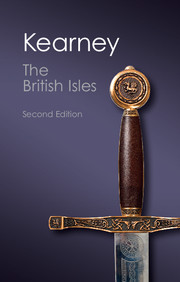Book contents
- Frontmatter
- Contents
- List of illustrations
- List of maps
- Preface to the first edition
- Preface to the second edition
- Map: the British Isles
- Introduction
- 1 The Celtic societies of the British Isles
- 2 The impact of Rome on the British Isles
- 3 The post-Roman centuries
- 4 The Vikings and the fall of the Old Order
- 5 The Norman and post-Norman ascendancy
- 6 The decline of the post-Norman empire
- 7 The making of an English empire
- 8 The remaking of an empire
- 9 The Britannic melting pot
- 10 The rise of ethnic politics
- 11 Between the wars
- 12 Withdrawal from empire
- 13 Post-imperial Britain: post-nationalist Ireland
- Afterword
- Selected reading list
- Index
5 - The Norman and post-Norman ascendancy
Published online by Cambridge University Press: 05 June 2014
- Frontmatter
- Contents
- List of illustrations
- List of maps
- Preface to the first edition
- Preface to the second edition
- Map: the British Isles
- Introduction
- 1 The Celtic societies of the British Isles
- 2 The impact of Rome on the British Isles
- 3 The post-Roman centuries
- 4 The Vikings and the fall of the Old Order
- 5 The Norman and post-Norman ascendancy
- 6 The decline of the post-Norman empire
- 7 The making of an English empire
- 8 The remaking of an empire
- 9 The Britannic melting pot
- 10 The rise of ethnic politics
- 11 Between the wars
- 12 Withdrawal from empire
- 13 Post-imperial Britain: post-nationalist Ireland
- Afterword
- Selected reading list
- Index
Summary
The victory of the Normans in 1066 brought revolutionary changes in its wake, not merely for southern Britain but in due course for the rest of the British Isles. Its effects were most immediate in ‘England’. William, who was crowned at Westminster Abbey on Christmas Day, lost little time in establishing himself and his followers. So complete was the Conquest that it is tempting to think in terms of a united kingdom. But the situation as it presented itself in the aftermath of the battle of Hastings was not yet so very different from what it had been earlier. Southern Britain was still divided into its distinctive cultures and these would continue to exist.
The itineraries of Cnut (d. 1035) and Edward (d. 1066), when mapped by a modern cartographer, make it clear that the heartland of the west Saxon monarchy was still the area south of the Thames. ‘Wessex’ was distinguished by large concentrations of royal and ecclesiastical land and by wealthy monasteries open to royal influence. In this region, royal writs and charters were effective and an efficient administration collected geld. This was also a society with a large percentage of unfree labour. There was some resistance in Wessex to the newcomers, at Exeter in 1069 for example, but for a long time to come this part of England was to provide a secure foundation for monarchy.
- Type
- Chapter
- Information
- The British IslesA History of Four Nations, pp. 92 - 131Publisher: Cambridge University PressPrint publication year: 2012



